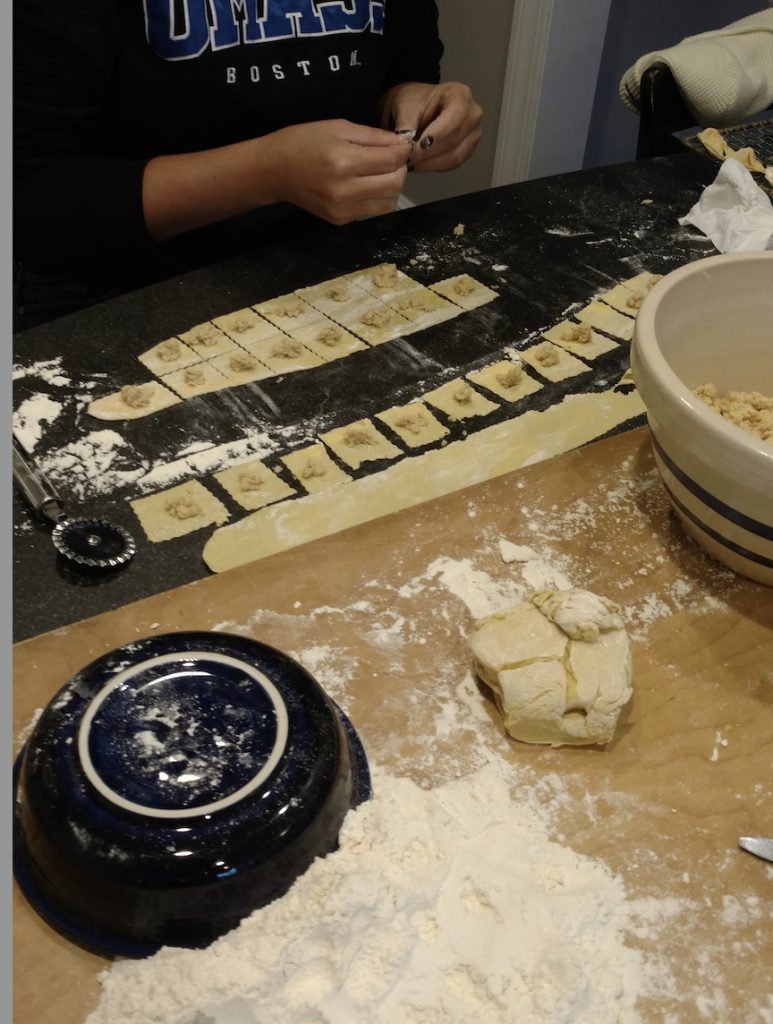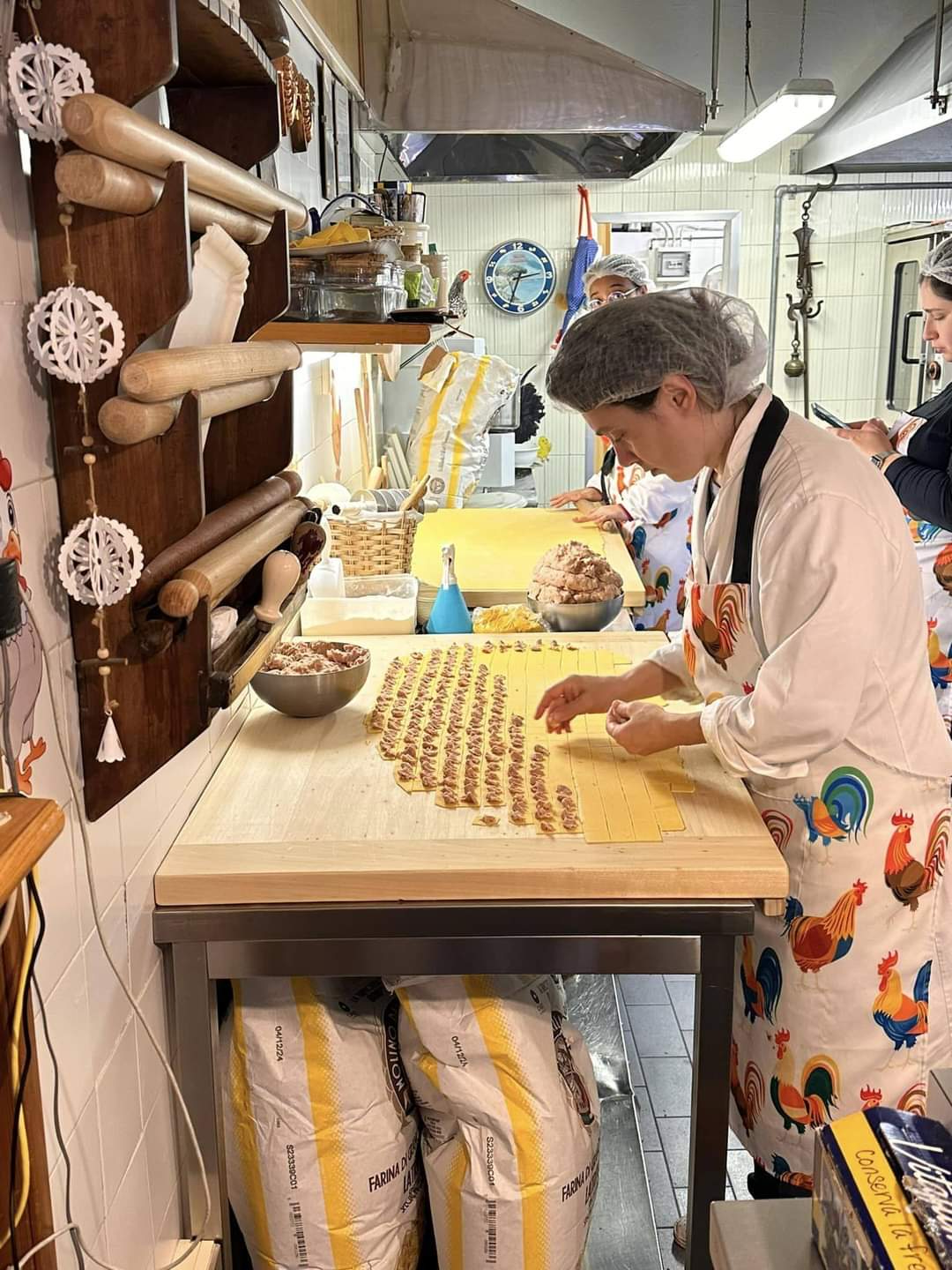To me, they are as iconic as Plymouth Rock, spark fierce debates, cross multiple generations and during my youth were made by various nationalities. They are, in fact one, of Plymouth’s culinary delights. You probably know them as Italian tortellini but in Plymouth speak, we call them tootalings!
First a little background for those unfamiliar with this North Plymouth institution. Tortellini arrived in Plymouth as early as the late 1870s as the waves of Italian Immigrants landed here to work at the Plymouth Cordage Company. They are small rounded ravioli-like pasta creations resembling a belly button, filled with meat and traditionally served in chicken broth. They originated from the Bologna and Modena areas of Italy and appear in Italian writings as early as 1570.
That said, that’s about all Plymouth folks can agree upon. (And maybe not even that!) I can almost guarantee you, a reader somewhere will respond to my descriptions with: “That’s not what we do!” As it happens, in my office, of the nine of us, five are related by blood or marriage and we don’t agree on all the details, either.
The making of tootalings are often a family affair and are done once, twice, or several times a year depending on one’s family traditions. The most common time to make them is prior to Thanksgiving, Christmas, and Easter. That’s what my family used to do. Unfortunately, the time-consuming tradition only happens once a year now.
As preparations begin, a host of Americanized Italian words are bantered about. Where’s the tooleed, how many eggs for the spoa, who’s making the ping? Those are the terms in my family. Others exist that I still may not be aware of and I welcome others sharing them with me.
Production begins with the making of the ping, or the filling. If anything sparks debate, it is the ping. During a trip to Bologna for Christmas in 2019, friends brought us to a traditional tortellini shop. What struck me immediately was the color of the ping. I asked our friends why the ping was pink. Somewhat shocked at the question, our friends informed us that to be considered an official Bolognese tortellini, they must contain pork, grated Parmesan cheese, egg, mortadella, salt, pepper, nutmeg and Bolognese prosciutto.
My family recipe contains just the pork, cheese, spices, and egg. Other families’ recipes vary and can include chicken, prosciutto, mortadella, beef, and ham. Arguments about the ingredients are often more about family tradition than anything. My brother and I argue if we should add the nutmeg during the cooking of the pork or during the mixing of the ingredients. (It’s actually after, as I have my mother’s handwritten recipe!) One office staff member insists the meat should be ground before cooking. (She received a tongue lashing that day from the rest of us!) Happily, the varied recipes reveal something very important: our recipes are close to 150 years old and represent the villages our families immigrated from and also the availability of ingredients found readily on the farms.
The second major component of the production is the making of the spoa, or the egg pasta that wraps the filling. Without controversy the pasta is made with egg and white flour. (What size eggs and the flour brand are always up for discussion.)

But how it is made often sparks debate. We start with the tooleed. The tooleed is the wooden board used for preparing the egg and flour pasta mixture. Our tooleed was my mother’s and is nothing more than a very well worn 80-year-old piece of 3 ⁄ 4 ” plywood. Making a ring of flour in the center of the tooleed, we fill the center with eggs and knead until it’s perfectly mixed. We still hand knead our pasta, a job reserved for my brother and me; others in town have now resorted to a food processor. (Gasp!) Once mixed, the pasta is hand rolled on the tooleed with a rolling pin. In our case, we then use a pasta machine and produce strips of pasta 3 to 4 inches wide and approximately five feet long.
Around a large table, fueled with wine and snacks, and with the pasta ready, we begin the actual filling and folding. In the center of the table our family has a large screen. Each family member is given a strip of pasta and passes a serrated pastry wheel back and forth. The wheel cuts the pasta into small squares. I called David Malagutti thinking he knew the name of the wheel that cut the pasta. He told me his family just used a knife; I hung up on the heretic. Our wheel is relatively new. We retired my great grandmother’s when it became so worn it was close to failure. It holds a place of honor in my kitchen in a small frame now.
This was also a point of contention between my Grandmother Fiocchi and my Grandmother Ruffini. The Fiocchi families came from the village of Palata Pepoli, due north of Bologna. The Ruffini family came from Brescello, northwest of Modena. The villages are only an hour apart but worlds away. The family legend is that when my parents first married, both grandmothers got together to make tootalings. It was their first and last time. It seems as though my Bolognese families start with a two inch square, my Modenese families start with a one inch square. It was enough of a difference that my grandmothers never made them together again. (There is also the story of them debating the Bolognese sauce versus Modenese Sauce. An article for the future! )
In the center of each of the cut pasta squares we place a small amount of ping. The pasta is then folded across diagonally, pinched closed, and then twisted into a shape that resembles the belly button. They are placed on the screen to dry. Other families dry their tootalingss on tablecloths. Once dried they are dispatched to quart freezer bags and stored in the freezer till they are ready to cook and eat.
The entire process takes anywhere from four to six hours. It involves lots of laughs, a huge amount of gossip about family members who chose not to come, and a fair amount of “tasting” the raw ping. This year each family member netted a quart bag and a half. I’m already through the full bag and saving the last half bag for myself. Sometime between Christmas and New Years, I’ll enjoy a bowl all to myself.
Architect Bill Fornaciari, a lifelong resident of Plymouth, is the owner of BF Architects in Plymouth. His firm specializes in residential work and historic preservation. Have a question or idea for this column? Email Bill at billfornaciari@gmail.com.

